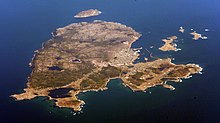Economy of Saint Pierre and Miquelon
 | |
| Currency | Euro, Canadian Dollar |
|---|---|
| Calendar year | |
| Statistics | |
| GDP | |
GDP per capita | |
GDP by sector | agriculture: 2%; industry: 15%; services: 83% (2006 est.) |
Labour force | 4,429 (2015 est.) |
Labour force by occupation | agriculture: 18%; industry: 41%; services: 41% (1996 est.) |
| Unemployment | |
| External | |
| Exports | |
Export goods | fish and fish products, soybeans, animal feed, mollusks and crustaceans, fox and mink pelts |
| Imports | |
Import goods | meat, clothing, fuel, electrical equipment, machinery, building materials |
The economy of Saint Pierre and Miquelon, due to the islands' location, has been dependent on fishing and servicing fishing fleets operating off the coast of Newfoundland. The economy has been declining, however, due to disputes with Canada over fishing quotas and a decline in the number of ships stopping at the islands.[1] In 1992 an arbitration panel awarded the islands an exclusive economic zone of 12,348 square kilometres (4,768 sq mi) to settle a longstanding territorial dispute with Canada, although it represents only 25 percent of what France had sought. The islands are heavily subsidized by France, which benefits the standard of living. The government hopes an expansion of tourism will boost economic prospects, and test drilling for oil may pave the way development of the energy sector.
See also[]
References[]
- ^ Robert Aldrich, John Connell (1992). France's Overseas Frontier: Départements Et Territoires D'outre-mer. Cambridge University Press. p. 59. ISBN 0-521-39061-3.
- Economy of Saint Pierre and Miquelon
- Saint Pierre and Miquelon stubs